Organizational Behavior Assignment
VerifiedAdded on 2020/12/10
|18
|4362
|38
Homework Assignment
AI Summary
This assignment explores the principles of organizational behavior, analyzing how culture, power dynamics, and motivation impact individual and team performance. It examines various theories, including Handy's cultural typology, Hofstede's cultural dimensions, Maslow's hierarchy of needs, Herzberg's two-factor theory, Vroom's expectancy theory, and Tuckman and Jensen's team development stages. The assignment also applies the Path-Goal theory to improve productivity and performance within an organizational context.
Contribute Materials
Your contribution can guide someone’s learning journey. Share your
documents today.
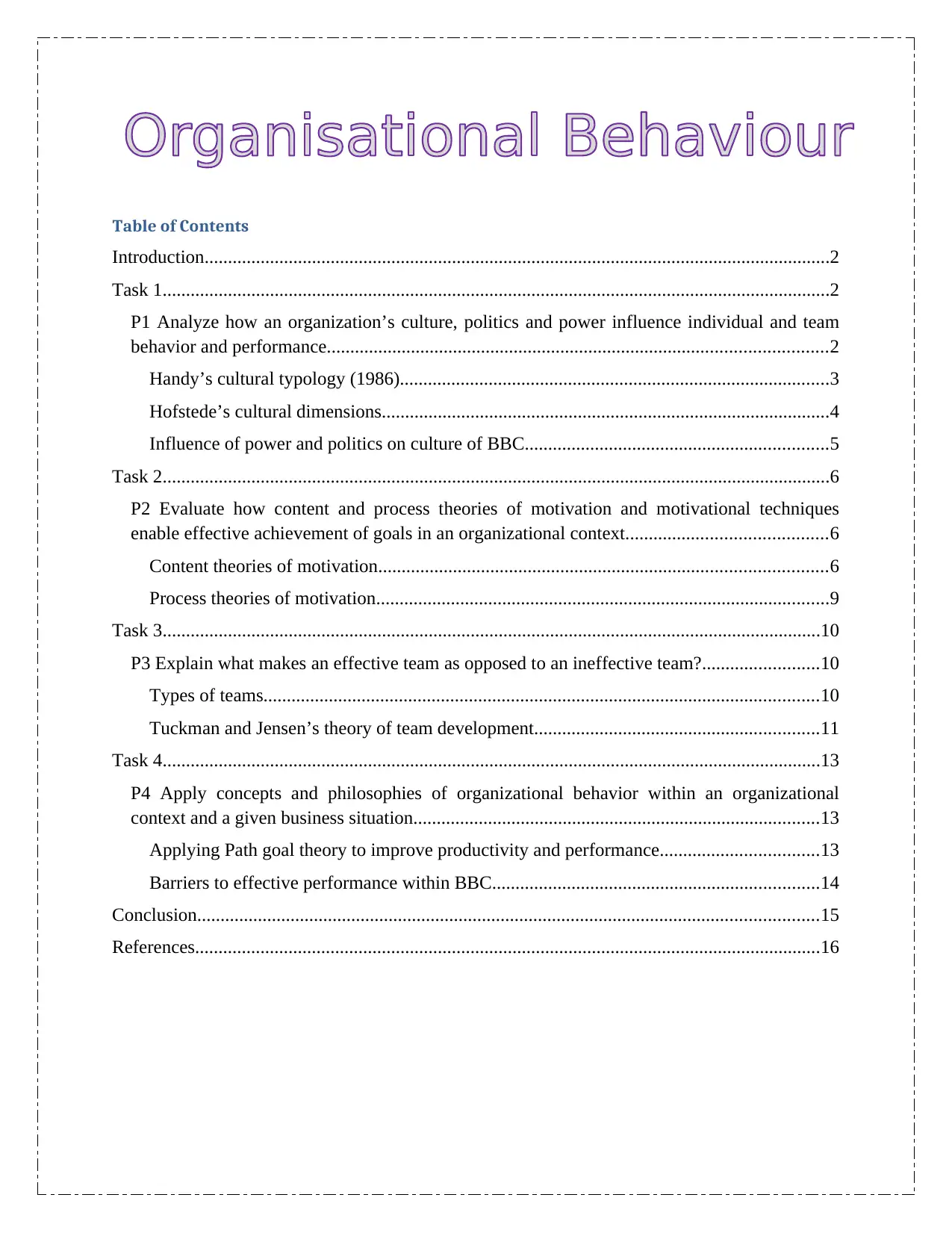
Table of Contents
Introduction......................................................................................................................................2
Task 1...............................................................................................................................................2
P1 Analyze how an organization’s culture, politics and power influence individual and team
behavior and performance...........................................................................................................2
Handy’s cultural typology (1986)............................................................................................3
Hofstede’s cultural dimensions................................................................................................4
Influence of power and politics on culture of BBC.................................................................5
Task 2...............................................................................................................................................6
P2 Evaluate how content and process theories of motivation and motivational techniques
enable effective achievement of goals in an organizational context...........................................6
Content theories of motivation................................................................................................6
Process theories of motivation.................................................................................................9
Task 3.............................................................................................................................................10
P3 Explain what makes an effective team as opposed to an ineffective team?.........................10
Types of teams.......................................................................................................................10
Tuckman and Jensen’s theory of team development.............................................................11
Task 4.............................................................................................................................................13
P4 Apply concepts and philosophies of organizational behavior within an organizational
context and a given business situation.......................................................................................13
Applying Path goal theory to improve productivity and performance..................................13
Barriers to effective performance within BBC......................................................................14
Conclusion.....................................................................................................................................15
References......................................................................................................................................16
Introduction......................................................................................................................................2
Task 1...............................................................................................................................................2
P1 Analyze how an organization’s culture, politics and power influence individual and team
behavior and performance...........................................................................................................2
Handy’s cultural typology (1986)............................................................................................3
Hofstede’s cultural dimensions................................................................................................4
Influence of power and politics on culture of BBC.................................................................5
Task 2...............................................................................................................................................6
P2 Evaluate how content and process theories of motivation and motivational techniques
enable effective achievement of goals in an organizational context...........................................6
Content theories of motivation................................................................................................6
Process theories of motivation.................................................................................................9
Task 3.............................................................................................................................................10
P3 Explain what makes an effective team as opposed to an ineffective team?.........................10
Types of teams.......................................................................................................................10
Tuckman and Jensen’s theory of team development.............................................................11
Task 4.............................................................................................................................................13
P4 Apply concepts and philosophies of organizational behavior within an organizational
context and a given business situation.......................................................................................13
Applying Path goal theory to improve productivity and performance..................................13
Barriers to effective performance within BBC......................................................................14
Conclusion.....................................................................................................................................15
References......................................................................................................................................16
Secure Best Marks with AI Grader
Need help grading? Try our AI Grader for instant feedback on your assignments.
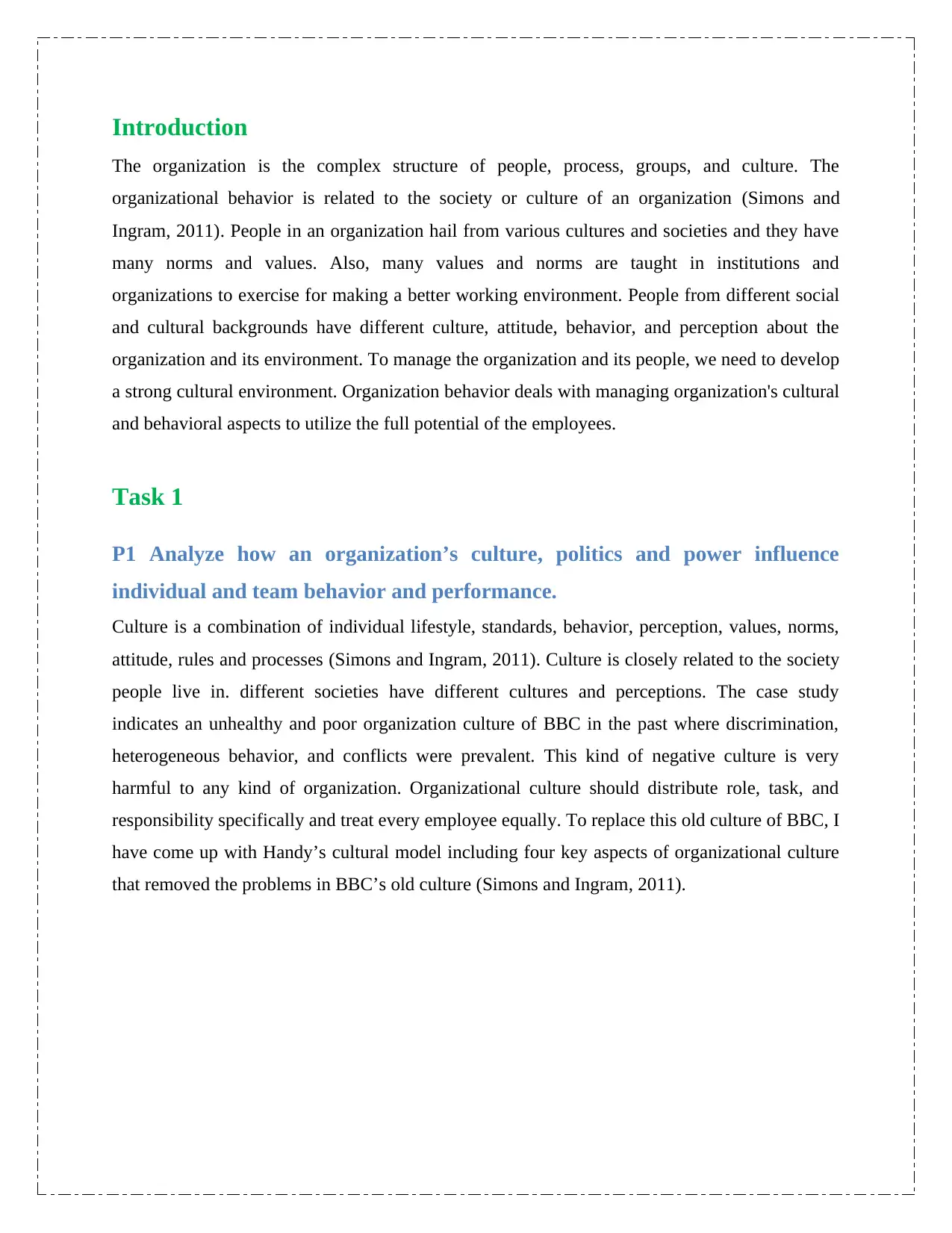
Introduction
The organization is the complex structure of people, process, groups, and culture. The
organizational behavior is related to the society or culture of an organization (Simons and
Ingram, 2011). People in an organization hail from various cultures and societies and they have
many norms and values. Also, many values and norms are taught in institutions and
organizations to exercise for making a better working environment. People from different social
and cultural backgrounds have different culture, attitude, behavior, and perception about the
organization and its environment. To manage the organization and its people, we need to develop
a strong cultural environment. Organization behavior deals with managing organization's cultural
and behavioral aspects to utilize the full potential of the employees.
Task 1
P1 Analyze how an organization’s culture, politics and power influence
individual and team behavior and performance.
Culture is a combination of individual lifestyle, standards, behavior, perception, values, norms,
attitude, rules and processes (Simons and Ingram, 2011). Culture is closely related to the society
people live in. different societies have different cultures and perceptions. The case study
indicates an unhealthy and poor organization culture of BBC in the past where discrimination,
heterogeneous behavior, and conflicts were prevalent. This kind of negative culture is very
harmful to any kind of organization. Organizational culture should distribute role, task, and
responsibility specifically and treat every employee equally. To replace this old culture of BBC, I
have come up with Handy’s cultural model including four key aspects of organizational culture
that removed the problems in BBC’s old culture (Simons and Ingram, 2011).
The organization is the complex structure of people, process, groups, and culture. The
organizational behavior is related to the society or culture of an organization (Simons and
Ingram, 2011). People in an organization hail from various cultures and societies and they have
many norms and values. Also, many values and norms are taught in institutions and
organizations to exercise for making a better working environment. People from different social
and cultural backgrounds have different culture, attitude, behavior, and perception about the
organization and its environment. To manage the organization and its people, we need to develop
a strong cultural environment. Organization behavior deals with managing organization's cultural
and behavioral aspects to utilize the full potential of the employees.
Task 1
P1 Analyze how an organization’s culture, politics and power influence
individual and team behavior and performance.
Culture is a combination of individual lifestyle, standards, behavior, perception, values, norms,
attitude, rules and processes (Simons and Ingram, 2011). Culture is closely related to the society
people live in. different societies have different cultures and perceptions. The case study
indicates an unhealthy and poor organization culture of BBC in the past where discrimination,
heterogeneous behavior, and conflicts were prevalent. This kind of negative culture is very
harmful to any kind of organization. Organizational culture should distribute role, task, and
responsibility specifically and treat every employee equally. To replace this old culture of BBC, I
have come up with Handy’s cultural model including four key aspects of organizational culture
that removed the problems in BBC’s old culture (Simons and Ingram, 2011).
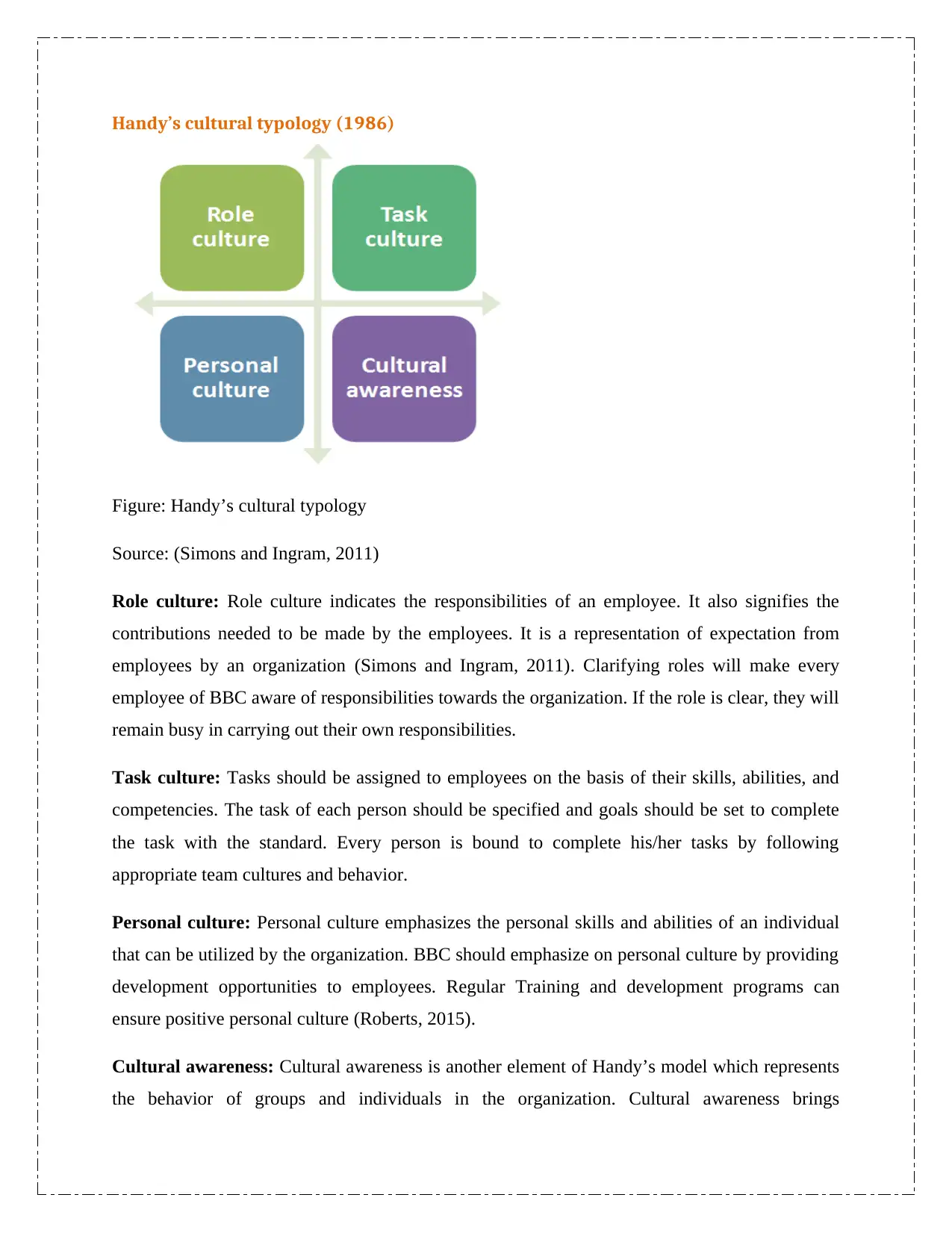
Handy’s cultural typology (1986)
Figure: Handy’s cultural typology
Source: (Simons and Ingram, 2011)
Role culture: Role culture indicates the responsibilities of an employee. It also signifies the
contributions needed to be made by the employees. It is a representation of expectation from
employees by an organization (Simons and Ingram, 2011). Clarifying roles will make every
employee of BBC aware of responsibilities towards the organization. If the role is clear, they will
remain busy in carrying out their own responsibilities.
Task culture: Tasks should be assigned to employees on the basis of their skills, abilities, and
competencies. The task of each person should be specified and goals should be set to complete
the task with the standard. Every person is bound to complete his/her tasks by following
appropriate team cultures and behavior.
Personal culture: Personal culture emphasizes the personal skills and abilities of an individual
that can be utilized by the organization. BBC should emphasize on personal culture by providing
development opportunities to employees. Regular Training and development programs can
ensure positive personal culture (Roberts, 2015).
Cultural awareness: Cultural awareness is another element of Handy’s model which represents
the behavior of groups and individuals in the organization. Cultural awareness brings
Figure: Handy’s cultural typology
Source: (Simons and Ingram, 2011)
Role culture: Role culture indicates the responsibilities of an employee. It also signifies the
contributions needed to be made by the employees. It is a representation of expectation from
employees by an organization (Simons and Ingram, 2011). Clarifying roles will make every
employee of BBC aware of responsibilities towards the organization. If the role is clear, they will
remain busy in carrying out their own responsibilities.
Task culture: Tasks should be assigned to employees on the basis of their skills, abilities, and
competencies. The task of each person should be specified and goals should be set to complete
the task with the standard. Every person is bound to complete his/her tasks by following
appropriate team cultures and behavior.
Personal culture: Personal culture emphasizes the personal skills and abilities of an individual
that can be utilized by the organization. BBC should emphasize on personal culture by providing
development opportunities to employees. Regular Training and development programs can
ensure positive personal culture (Roberts, 2015).
Cultural awareness: Cultural awareness is another element of Handy’s model which represents
the behavior of groups and individuals in the organization. Cultural awareness brings
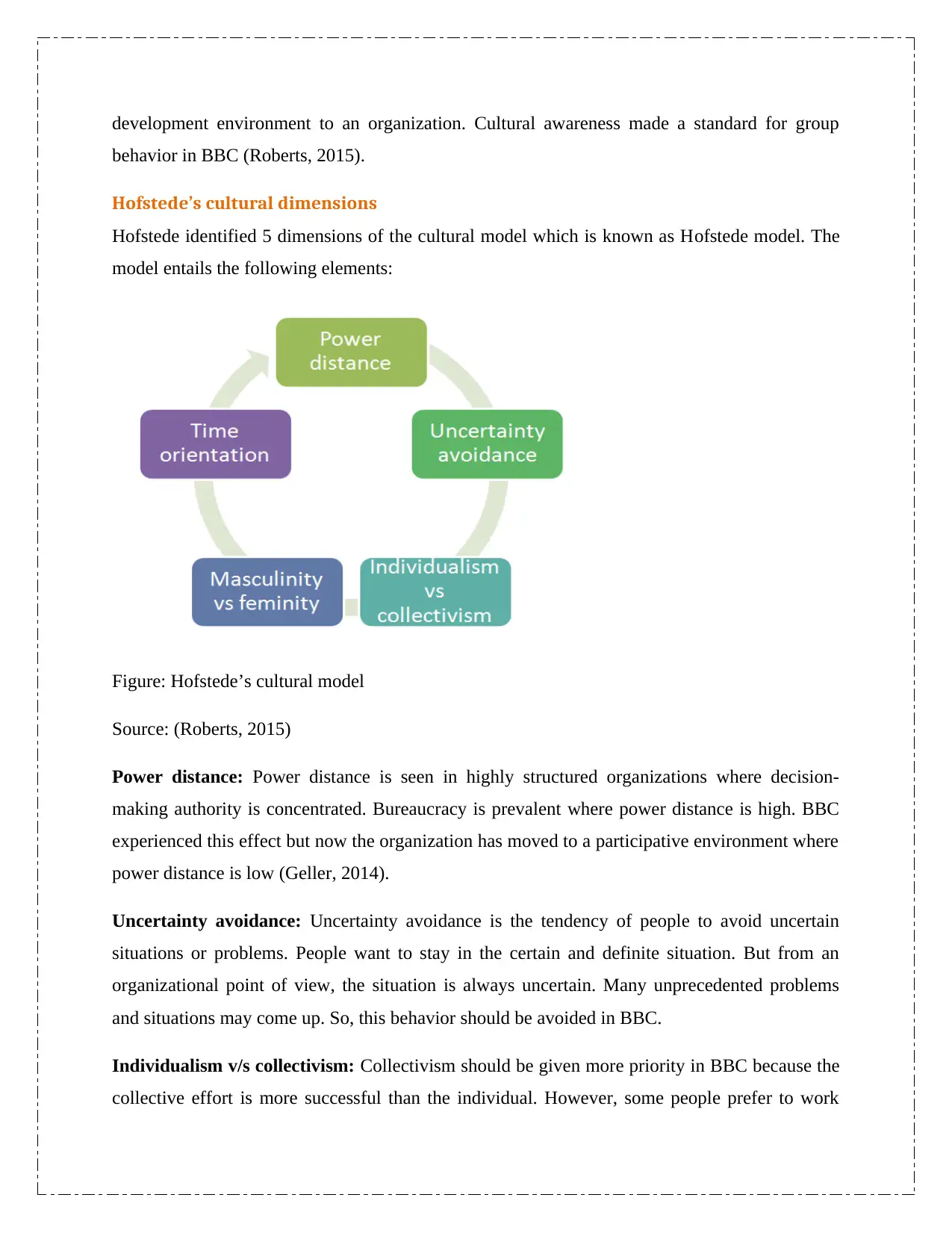
development environment to an organization. Cultural awareness made a standard for group
behavior in BBC (Roberts, 2015).
Hofstede’s cultural dimensions
Hofstede identified 5 dimensions of the cultural model which is known as Hofstede model. The
model entails the following elements:
Figure: Hofstede’s cultural model
Source: (Roberts, 2015)
Power distance: Power distance is seen in highly structured organizations where decision-
making authority is concentrated. Bureaucracy is prevalent where power distance is high. BBC
experienced this effect but now the organization has moved to a participative environment where
power distance is low (Geller, 2014).
Uncertainty avoidance: Uncertainty avoidance is the tendency of people to avoid uncertain
situations or problems. People want to stay in the certain and definite situation. But from an
organizational point of view, the situation is always uncertain. Many unprecedented problems
and situations may come up. So, this behavior should be avoided in BBC.
Individualism v/s collectivism: Collectivism should be given more priority in BBC because the
collective effort is more successful than the individual. However, some people prefer to work
behavior in BBC (Roberts, 2015).
Hofstede’s cultural dimensions
Hofstede identified 5 dimensions of the cultural model which is known as Hofstede model. The
model entails the following elements:
Figure: Hofstede’s cultural model
Source: (Roberts, 2015)
Power distance: Power distance is seen in highly structured organizations where decision-
making authority is concentrated. Bureaucracy is prevalent where power distance is high. BBC
experienced this effect but now the organization has moved to a participative environment where
power distance is low (Geller, 2014).
Uncertainty avoidance: Uncertainty avoidance is the tendency of people to avoid uncertain
situations or problems. People want to stay in the certain and definite situation. But from an
organizational point of view, the situation is always uncertain. Many unprecedented problems
and situations may come up. So, this behavior should be avoided in BBC.
Individualism v/s collectivism: Collectivism should be given more priority in BBC because the
collective effort is more successful than the individual. However, some people prefer to work
Secure Best Marks with AI Grader
Need help grading? Try our AI Grader for instant feedback on your assignments.
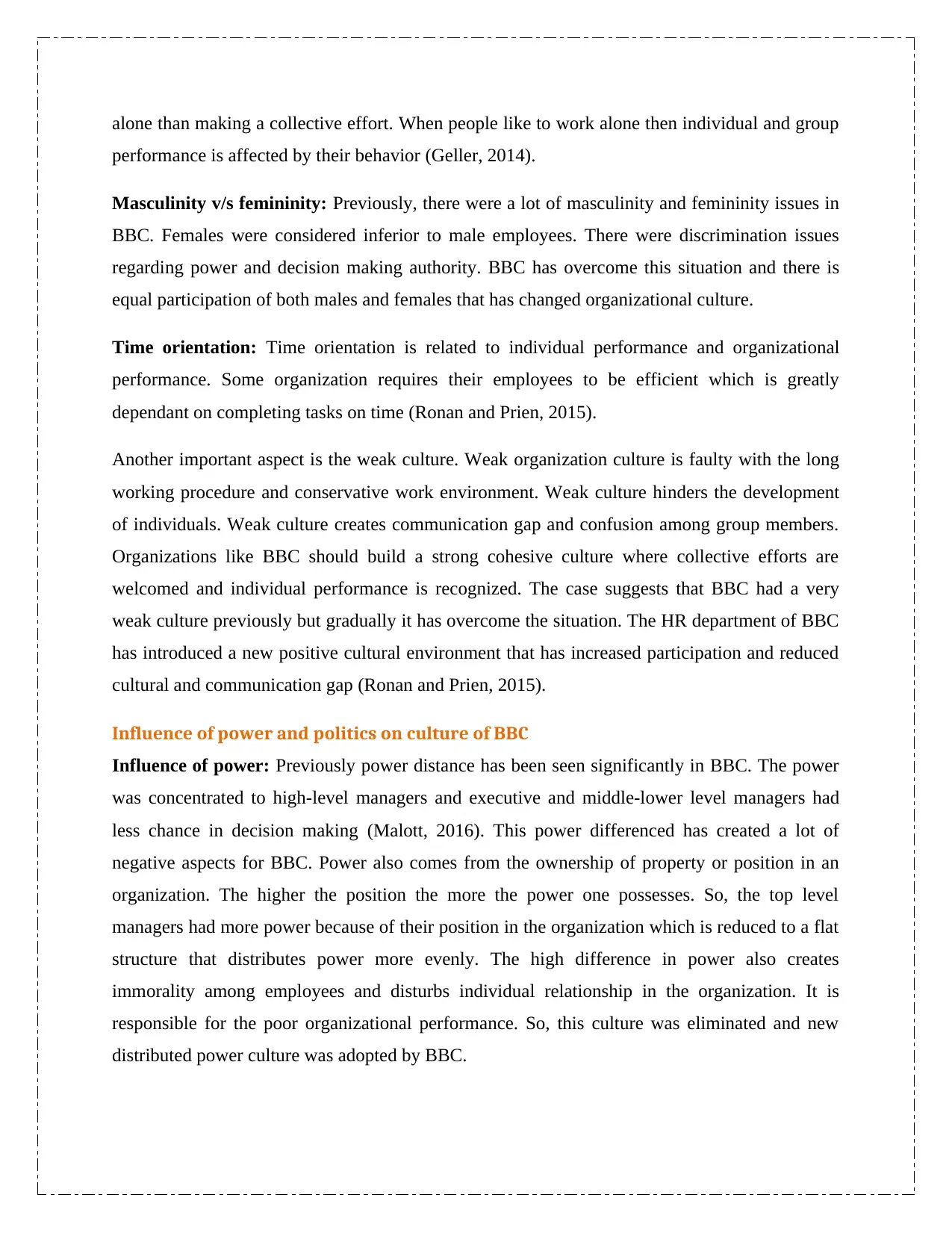
alone than making a collective effort. When people like to work alone then individual and group
performance is affected by their behavior (Geller, 2014).
Masculinity v/s femininity: Previously, there were a lot of masculinity and femininity issues in
BBC. Females were considered inferior to male employees. There were discrimination issues
regarding power and decision making authority. BBC has overcome this situation and there is
equal participation of both males and females that has changed organizational culture.
Time orientation: Time orientation is related to individual performance and organizational
performance. Some organization requires their employees to be efficient which is greatly
dependant on completing tasks on time (Ronan and Prien, 2015).
Another important aspect is the weak culture. Weak organization culture is faulty with the long
working procedure and conservative work environment. Weak culture hinders the development
of individuals. Weak culture creates communication gap and confusion among group members.
Organizations like BBC should build a strong cohesive culture where collective efforts are
welcomed and individual performance is recognized. The case suggests that BBC had a very
weak culture previously but gradually it has overcome the situation. The HR department of BBC
has introduced a new positive cultural environment that has increased participation and reduced
cultural and communication gap (Ronan and Prien, 2015).
Influence of power and politics on culture of BBC
Influence of power: Previously power distance has been seen significantly in BBC. The power
was concentrated to high-level managers and executive and middle-lower level managers had
less chance in decision making (Malott, 2016). This power differenced has created a lot of
negative aspects for BBC. Power also comes from the ownership of property or position in an
organization. The higher the position the more the power one possesses. So, the top level
managers had more power because of their position in the organization which is reduced to a flat
structure that distributes power more evenly. The high difference in power also creates
immorality among employees and disturbs individual relationship in the organization. It is
responsible for the poor organizational performance. So, this culture was eliminated and new
distributed power culture was adopted by BBC.
performance is affected by their behavior (Geller, 2014).
Masculinity v/s femininity: Previously, there were a lot of masculinity and femininity issues in
BBC. Females were considered inferior to male employees. There were discrimination issues
regarding power and decision making authority. BBC has overcome this situation and there is
equal participation of both males and females that has changed organizational culture.
Time orientation: Time orientation is related to individual performance and organizational
performance. Some organization requires their employees to be efficient which is greatly
dependant on completing tasks on time (Ronan and Prien, 2015).
Another important aspect is the weak culture. Weak organization culture is faulty with the long
working procedure and conservative work environment. Weak culture hinders the development
of individuals. Weak culture creates communication gap and confusion among group members.
Organizations like BBC should build a strong cohesive culture where collective efforts are
welcomed and individual performance is recognized. The case suggests that BBC had a very
weak culture previously but gradually it has overcome the situation. The HR department of BBC
has introduced a new positive cultural environment that has increased participation and reduced
cultural and communication gap (Ronan and Prien, 2015).
Influence of power and politics on culture of BBC
Influence of power: Previously power distance has been seen significantly in BBC. The power
was concentrated to high-level managers and executive and middle-lower level managers had
less chance in decision making (Malott, 2016). This power differenced has created a lot of
negative aspects for BBC. Power also comes from the ownership of property or position in an
organization. The higher the position the more the power one possesses. So, the top level
managers had more power because of their position in the organization which is reduced to a flat
structure that distributes power more evenly. The high difference in power also creates
immorality among employees and disturbs individual relationship in the organization. It is
responsible for the poor organizational performance. So, this culture was eliminated and new
distributed power culture was adopted by BBC.
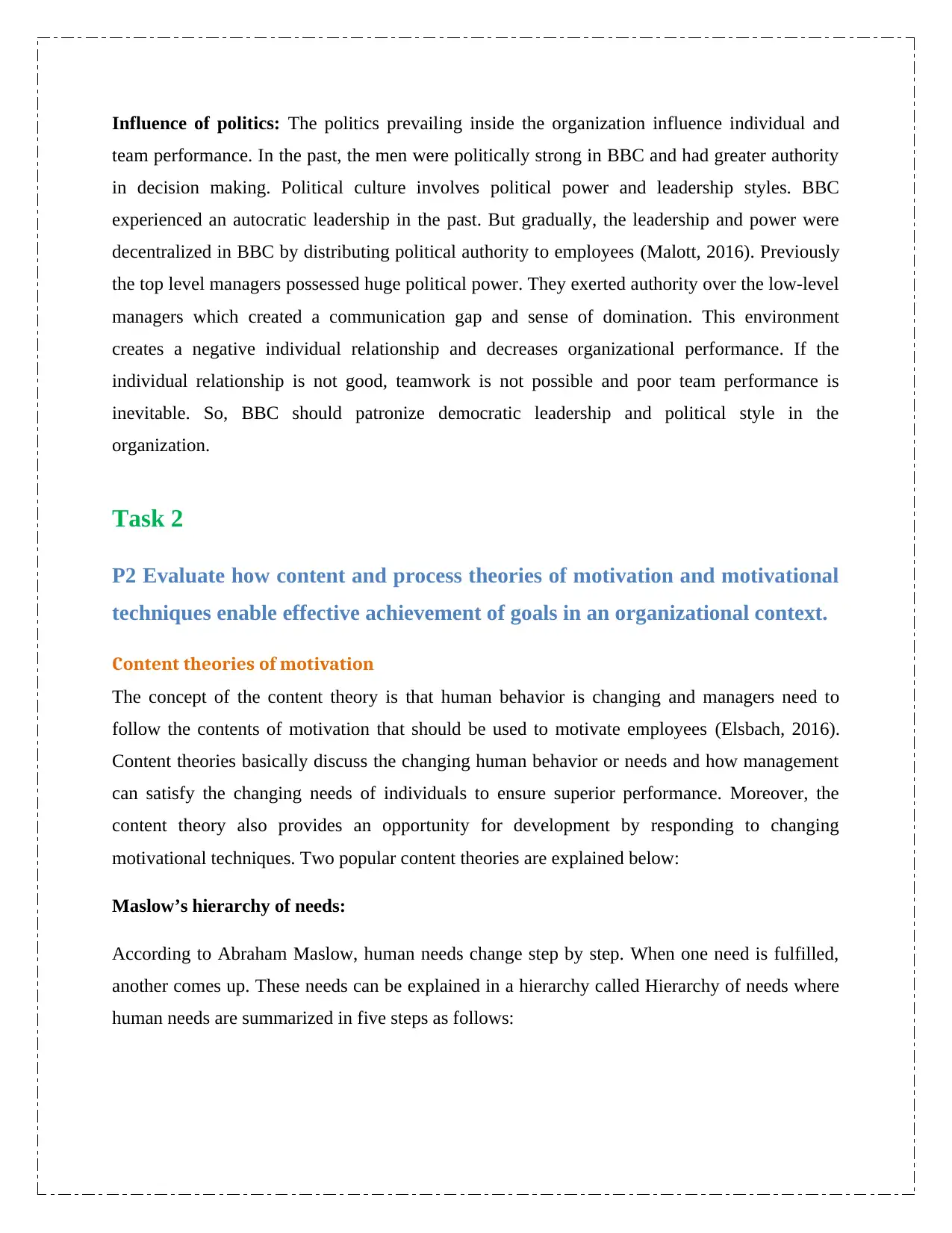
Influence of politics: The politics prevailing inside the organization influence individual and
team performance. In the past, the men were politically strong in BBC and had greater authority
in decision making. Political culture involves political power and leadership styles. BBC
experienced an autocratic leadership in the past. But gradually, the leadership and power were
decentralized in BBC by distributing political authority to employees (Malott, 2016). Previously
the top level managers possessed huge political power. They exerted authority over the low-level
managers which created a communication gap and sense of domination. This environment
creates a negative individual relationship and decreases organizational performance. If the
individual relationship is not good, teamwork is not possible and poor team performance is
inevitable. So, BBC should patronize democratic leadership and political style in the
organization.
Task 2
P2 Evaluate how content and process theories of motivation and motivational
techniques enable effective achievement of goals in an organizational context.
Content theories of motivation
The concept of the content theory is that human behavior is changing and managers need to
follow the contents of motivation that should be used to motivate employees (Elsbach, 2016).
Content theories basically discuss the changing human behavior or needs and how management
can satisfy the changing needs of individuals to ensure superior performance. Moreover, the
content theory also provides an opportunity for development by responding to changing
motivational techniques. Two popular content theories are explained below:
Maslow’s hierarchy of needs:
According to Abraham Maslow, human needs change step by step. When one need is fulfilled,
another comes up. These needs can be explained in a hierarchy called Hierarchy of needs where
human needs are summarized in five steps as follows:
team performance. In the past, the men were politically strong in BBC and had greater authority
in decision making. Political culture involves political power and leadership styles. BBC
experienced an autocratic leadership in the past. But gradually, the leadership and power were
decentralized in BBC by distributing political authority to employees (Malott, 2016). Previously
the top level managers possessed huge political power. They exerted authority over the low-level
managers which created a communication gap and sense of domination. This environment
creates a negative individual relationship and decreases organizational performance. If the
individual relationship is not good, teamwork is not possible and poor team performance is
inevitable. So, BBC should patronize democratic leadership and political style in the
organization.
Task 2
P2 Evaluate how content and process theories of motivation and motivational
techniques enable effective achievement of goals in an organizational context.
Content theories of motivation
The concept of the content theory is that human behavior is changing and managers need to
follow the contents of motivation that should be used to motivate employees (Elsbach, 2016).
Content theories basically discuss the changing human behavior or needs and how management
can satisfy the changing needs of individuals to ensure superior performance. Moreover, the
content theory also provides an opportunity for development by responding to changing
motivational techniques. Two popular content theories are explained below:
Maslow’s hierarchy of needs:
According to Abraham Maslow, human needs change step by step. When one need is fulfilled,
another comes up. These needs can be explained in a hierarchy called Hierarchy of needs where
human needs are summarized in five steps as follows:
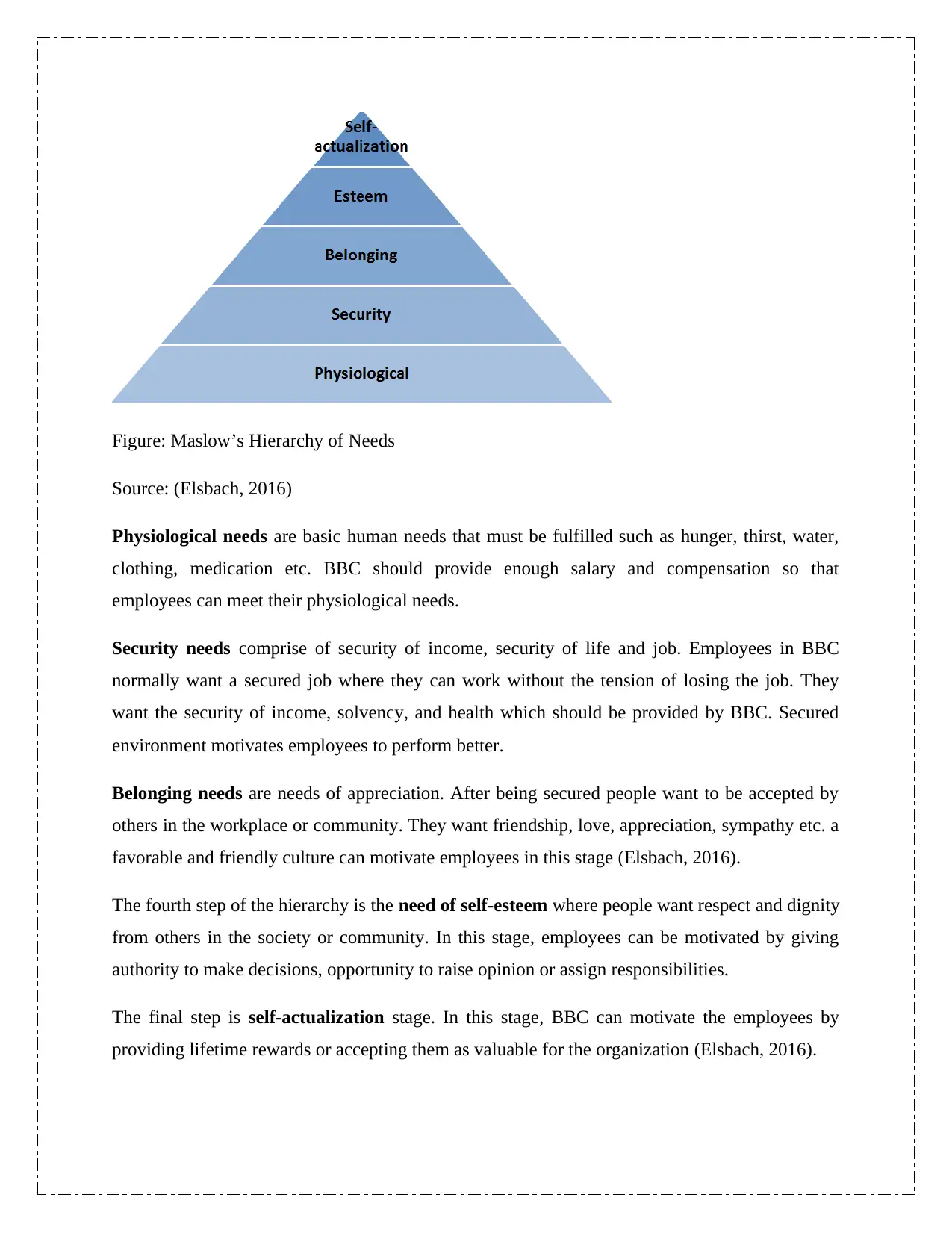
Figure: Maslow’s Hierarchy of Needs
Source: (Elsbach, 2016)
Physiological needs are basic human needs that must be fulfilled such as hunger, thirst, water,
clothing, medication etc. BBC should provide enough salary and compensation so that
employees can meet their physiological needs.
Security needs comprise of security of income, security of life and job. Employees in BBC
normally want a secured job where they can work without the tension of losing the job. They
want the security of income, solvency, and health which should be provided by BBC. Secured
environment motivates employees to perform better.
Belonging needs are needs of appreciation. After being secured people want to be accepted by
others in the workplace or community. They want friendship, love, appreciation, sympathy etc. a
favorable and friendly culture can motivate employees in this stage (Elsbach, 2016).
The fourth step of the hierarchy is the need of self-esteem where people want respect and dignity
from others in the society or community. In this stage, employees can be motivated by giving
authority to make decisions, opportunity to raise opinion or assign responsibilities.
The final step is self-actualization stage. In this stage, BBC can motivate the employees by
providing lifetime rewards or accepting them as valuable for the organization (Elsbach, 2016).
Source: (Elsbach, 2016)
Physiological needs are basic human needs that must be fulfilled such as hunger, thirst, water,
clothing, medication etc. BBC should provide enough salary and compensation so that
employees can meet their physiological needs.
Security needs comprise of security of income, security of life and job. Employees in BBC
normally want a secured job where they can work without the tension of losing the job. They
want the security of income, solvency, and health which should be provided by BBC. Secured
environment motivates employees to perform better.
Belonging needs are needs of appreciation. After being secured people want to be accepted by
others in the workplace or community. They want friendship, love, appreciation, sympathy etc. a
favorable and friendly culture can motivate employees in this stage (Elsbach, 2016).
The fourth step of the hierarchy is the need of self-esteem where people want respect and dignity
from others in the society or community. In this stage, employees can be motivated by giving
authority to make decisions, opportunity to raise opinion or assign responsibilities.
The final step is self-actualization stage. In this stage, BBC can motivate the employees by
providing lifetime rewards or accepting them as valuable for the organization (Elsbach, 2016).
Paraphrase This Document
Need a fresh take? Get an instant paraphrase of this document with our AI Paraphraser
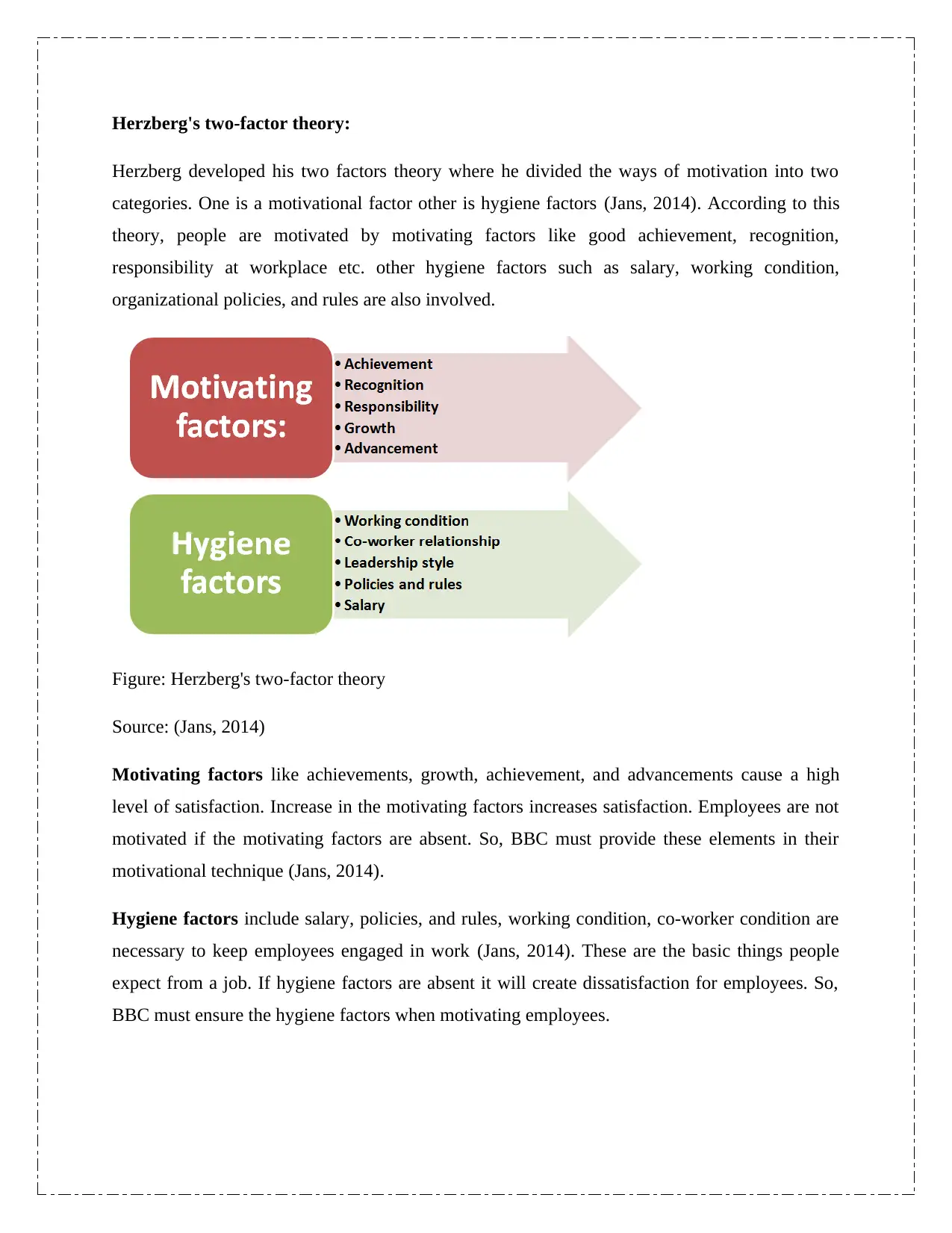
Herzberg's two-factor theory:
Herzberg developed his two factors theory where he divided the ways of motivation into two
categories. One is a motivational factor other is hygiene factors (Jans, 2014). According to this
theory, people are motivated by motivating factors like good achievement, recognition,
responsibility at workplace etc. other hygiene factors such as salary, working condition,
organizational policies, and rules are also involved.
Figure: Herzberg's two-factor theory
Source: (Jans, 2014)
Motivating factors like achievements, growth, achievement, and advancements cause a high
level of satisfaction. Increase in the motivating factors increases satisfaction. Employees are not
motivated if the motivating factors are absent. So, BBC must provide these elements in their
motivational technique (Jans, 2014).
Hygiene factors include salary, policies, and rules, working condition, co-worker condition are
necessary to keep employees engaged in work (Jans, 2014). These are the basic things people
expect from a job. If hygiene factors are absent it will create dissatisfaction for employees. So,
BBC must ensure the hygiene factors when motivating employees.
Herzberg developed his two factors theory where he divided the ways of motivation into two
categories. One is a motivational factor other is hygiene factors (Jans, 2014). According to this
theory, people are motivated by motivating factors like good achievement, recognition,
responsibility at workplace etc. other hygiene factors such as salary, working condition,
organizational policies, and rules are also involved.
Figure: Herzberg's two-factor theory
Source: (Jans, 2014)
Motivating factors like achievements, growth, achievement, and advancements cause a high
level of satisfaction. Increase in the motivating factors increases satisfaction. Employees are not
motivated if the motivating factors are absent. So, BBC must provide these elements in their
motivational technique (Jans, 2014).
Hygiene factors include salary, policies, and rules, working condition, co-worker condition are
necessary to keep employees engaged in work (Jans, 2014). These are the basic things people
expect from a job. If hygiene factors are absent it will create dissatisfaction for employees. So,
BBC must ensure the hygiene factors when motivating employees.

Process theories of motivation
Unlike content theories, process theories determine how individual behavior is changed by
motivation (Hellriegel and Slocum, 2013). Process theories seek to identify the behavior of
human pattern. Two popular process theories of motivation are Expectancy Theory by Victor
Vroom and Equity Theory of J. Stacey Adams.
Expectancy theory:
Victor Vroom developed expectancy theory which determines the pattern of change in human
behavior.
Figure: expectancy theory of Victor Vroom
Source: (Hellriegel and Slocum, 2013)
This theory deals with evaluating the change in human behavior. It determines how behavior
changes by the efforts of people. According to this theory, people make efforts to achieve certain
performance that leads to certain rewards, thus creating a process of motivation (Hellriegel and
Slocum, 2013). Valence is created by the performance. Performance is based on skills, abilities,
and competencies of employees that must be determined by BBC. So, the technique here for
BBC is to assign tasks that can be done by using individual skills and abilities. If performance is
satisfactory, BBC should give rewards to the employee to motivate.
Unlike content theories, process theories determine how individual behavior is changed by
motivation (Hellriegel and Slocum, 2013). Process theories seek to identify the behavior of
human pattern. Two popular process theories of motivation are Expectancy Theory by Victor
Vroom and Equity Theory of J. Stacey Adams.
Expectancy theory:
Victor Vroom developed expectancy theory which determines the pattern of change in human
behavior.
Figure: expectancy theory of Victor Vroom
Source: (Hellriegel and Slocum, 2013)
This theory deals with evaluating the change in human behavior. It determines how behavior
changes by the efforts of people. According to this theory, people make efforts to achieve certain
performance that leads to certain rewards, thus creating a process of motivation (Hellriegel and
Slocum, 2013). Valence is created by the performance. Performance is based on skills, abilities,
and competencies of employees that must be determined by BBC. So, the technique here for
BBC is to assign tasks that can be done by using individual skills and abilities. If performance is
satisfactory, BBC should give rewards to the employee to motivate.
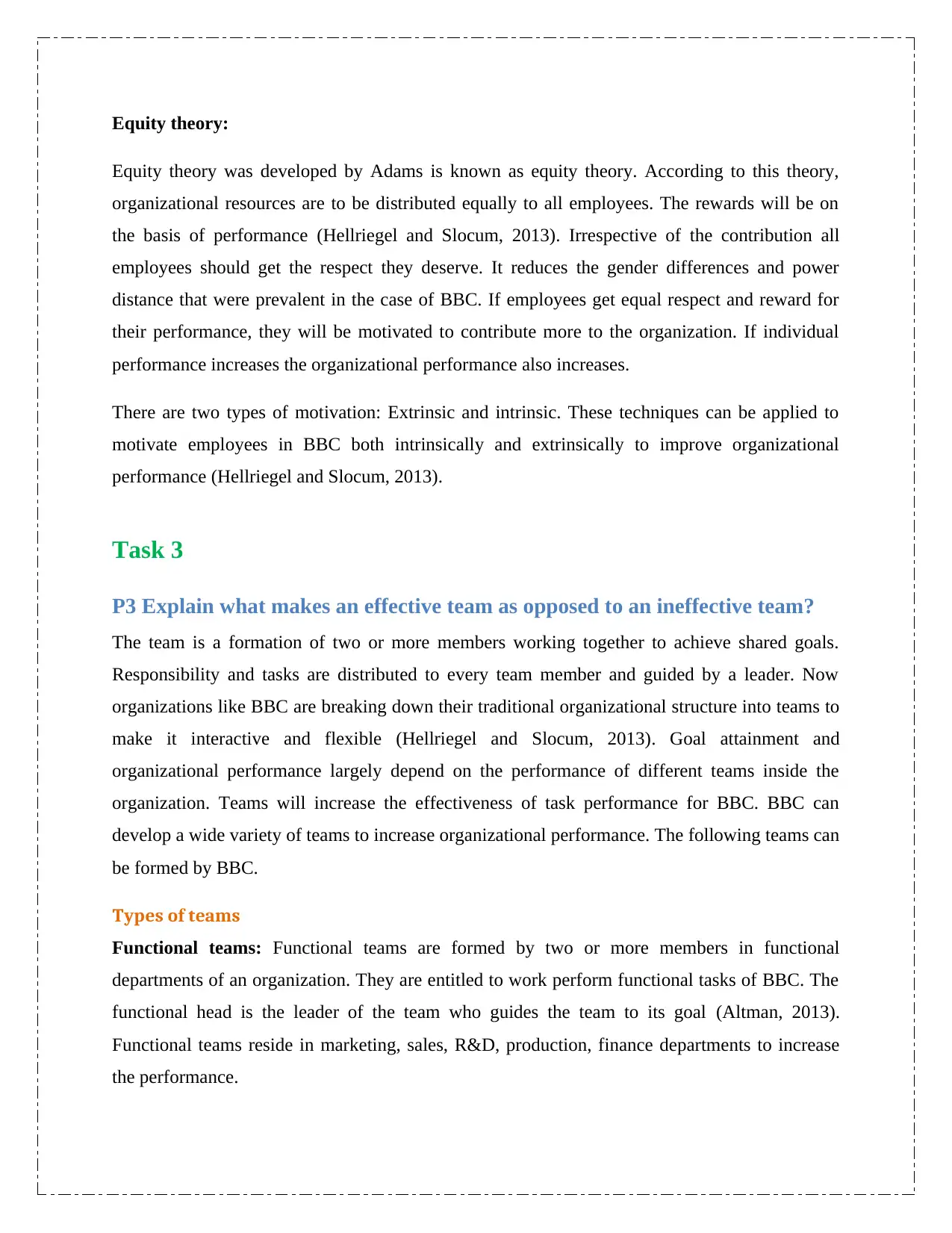
Equity theory:
Equity theory was developed by Adams is known as equity theory. According to this theory,
organizational resources are to be distributed equally to all employees. The rewards will be on
the basis of performance (Hellriegel and Slocum, 2013). Irrespective of the contribution all
employees should get the respect they deserve. It reduces the gender differences and power
distance that were prevalent in the case of BBC. If employees get equal respect and reward for
their performance, they will be motivated to contribute more to the organization. If individual
performance increases the organizational performance also increases.
There are two types of motivation: Extrinsic and intrinsic. These techniques can be applied to
motivate employees in BBC both intrinsically and extrinsically to improve organizational
performance (Hellriegel and Slocum, 2013).
Task 3
P3 Explain what makes an effective team as opposed to an ineffective team?
The team is a formation of two or more members working together to achieve shared goals.
Responsibility and tasks are distributed to every team member and guided by a leader. Now
organizations like BBC are breaking down their traditional organizational structure into teams to
make it interactive and flexible (Hellriegel and Slocum, 2013). Goal attainment and
organizational performance largely depend on the performance of different teams inside the
organization. Teams will increase the effectiveness of task performance for BBC. BBC can
develop a wide variety of teams to increase organizational performance. The following teams can
be formed by BBC.
Types of teams
Functional teams: Functional teams are formed by two or more members in functional
departments of an organization. They are entitled to work perform functional tasks of BBC. The
functional head is the leader of the team who guides the team to its goal (Altman, 2013).
Functional teams reside in marketing, sales, R&D, production, finance departments to increase
the performance.
Equity theory was developed by Adams is known as equity theory. According to this theory,
organizational resources are to be distributed equally to all employees. The rewards will be on
the basis of performance (Hellriegel and Slocum, 2013). Irrespective of the contribution all
employees should get the respect they deserve. It reduces the gender differences and power
distance that were prevalent in the case of BBC. If employees get equal respect and reward for
their performance, they will be motivated to contribute more to the organization. If individual
performance increases the organizational performance also increases.
There are two types of motivation: Extrinsic and intrinsic. These techniques can be applied to
motivate employees in BBC both intrinsically and extrinsically to improve organizational
performance (Hellriegel and Slocum, 2013).
Task 3
P3 Explain what makes an effective team as opposed to an ineffective team?
The team is a formation of two or more members working together to achieve shared goals.
Responsibility and tasks are distributed to every team member and guided by a leader. Now
organizations like BBC are breaking down their traditional organizational structure into teams to
make it interactive and flexible (Hellriegel and Slocum, 2013). Goal attainment and
organizational performance largely depend on the performance of different teams inside the
organization. Teams will increase the effectiveness of task performance for BBC. BBC can
develop a wide variety of teams to increase organizational performance. The following teams can
be formed by BBC.
Types of teams
Functional teams: Functional teams are formed by two or more members in functional
departments of an organization. They are entitled to work perform functional tasks of BBC. The
functional head is the leader of the team who guides the team to its goal (Altman, 2013).
Functional teams reside in marketing, sales, R&D, production, finance departments to increase
the performance.
Secure Best Marks with AI Grader
Need help grading? Try our AI Grader for instant feedback on your assignments.

Problem-solving teams: This is a specialized team which solves organizational problems. They
have multiples skills and from multiple backgrounds (Altman, 2013). They have technical and
conceptual skills to solve routine and complex problems. Problems faced by BBC like reduced
performance and employee turnover can be solved by these teams.
Project teams: Project teams perform temporary endeavor to make a project successful. BBC
takes up many projects which needed specialized teams to accomplish tasks within the limited
time frame (Altman, 2013). Project team success is essential in making organizational
performance up to the mark.
Virtual teams: Virtual teams are located in distant locations and interact using the video
conferencing or web applications. Previously teams used audio, mail, fax technologies to
communicate but, with the proliferation of internet and web they can communicate via Skype,
Messenger or other communication tools. Virtual teams can be used by BBC when an emergency
situation comes up (Altman, 2013).
Tuckman and Jensen’s theory of team development
According to Tuckman and Jensen, there are five stages of team development. To develop a team
for BBC, we have to follow the stages of this theory.
Figure: Tuckman and Jensen's theory of team development
have multiples skills and from multiple backgrounds (Altman, 2013). They have technical and
conceptual skills to solve routine and complex problems. Problems faced by BBC like reduced
performance and employee turnover can be solved by these teams.
Project teams: Project teams perform temporary endeavor to make a project successful. BBC
takes up many projects which needed specialized teams to accomplish tasks within the limited
time frame (Altman, 2013). Project team success is essential in making organizational
performance up to the mark.
Virtual teams: Virtual teams are located in distant locations and interact using the video
conferencing or web applications. Previously teams used audio, mail, fax technologies to
communicate but, with the proliferation of internet and web they can communicate via Skype,
Messenger or other communication tools. Virtual teams can be used by BBC when an emergency
situation comes up (Altman, 2013).
Tuckman and Jensen’s theory of team development
According to Tuckman and Jensen, there are five stages of team development. To develop a team
for BBC, we have to follow the stages of this theory.
Figure: Tuckman and Jensen's theory of team development
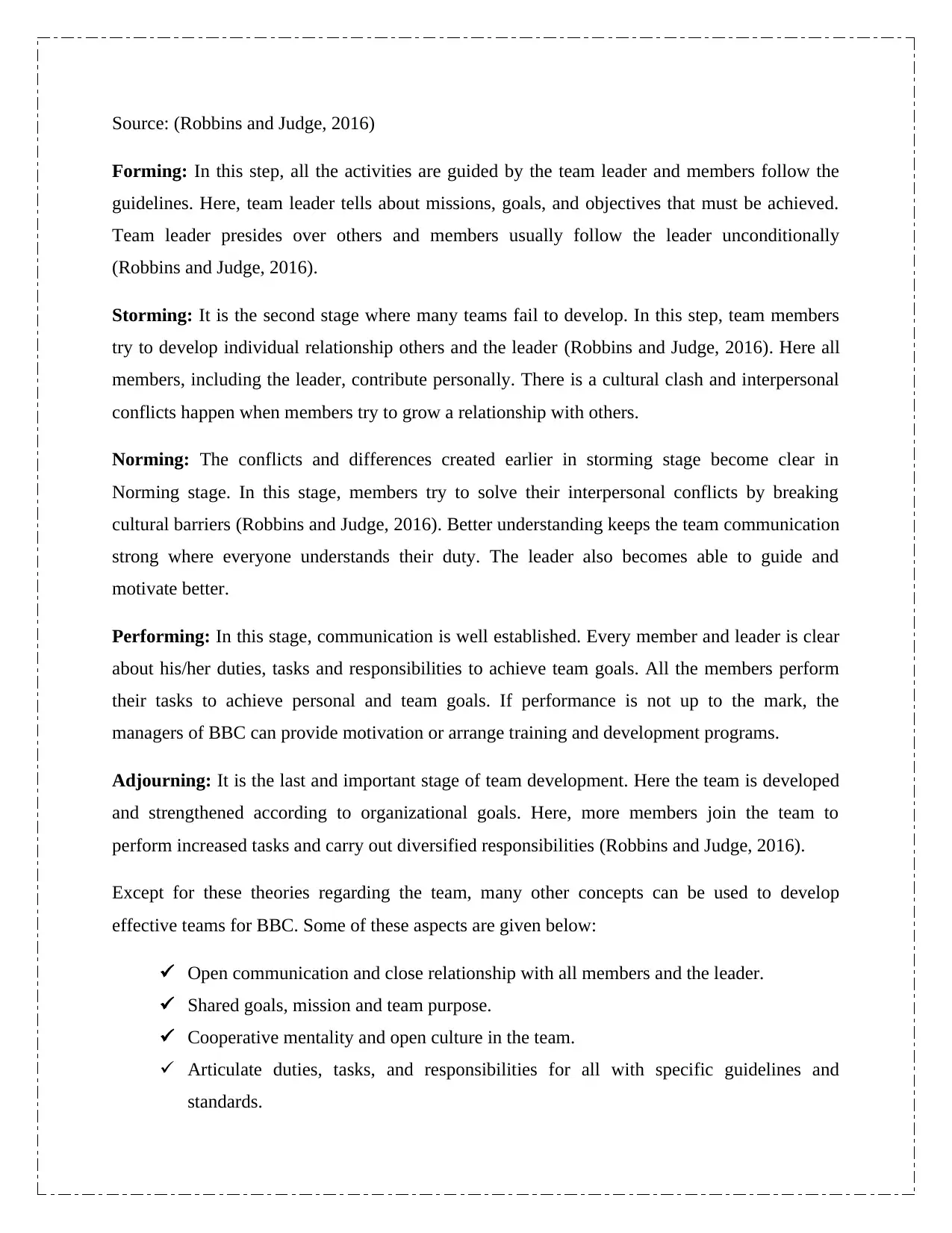
Source: (Robbins and Judge, 2016)
Forming: In this step, all the activities are guided by the team leader and members follow the
guidelines. Here, team leader tells about missions, goals, and objectives that must be achieved.
Team leader presides over others and members usually follow the leader unconditionally
(Robbins and Judge, 2016).
Storming: It is the second stage where many teams fail to develop. In this step, team members
try to develop individual relationship others and the leader (Robbins and Judge, 2016). Here all
members, including the leader, contribute personally. There is a cultural clash and interpersonal
conflicts happen when members try to grow a relationship with others.
Norming: The conflicts and differences created earlier in storming stage become clear in
Norming stage. In this stage, members try to solve their interpersonal conflicts by breaking
cultural barriers (Robbins and Judge, 2016). Better understanding keeps the team communication
strong where everyone understands their duty. The leader also becomes able to guide and
motivate better.
Performing: In this stage, communication is well established. Every member and leader is clear
about his/her duties, tasks and responsibilities to achieve team goals. All the members perform
their tasks to achieve personal and team goals. If performance is not up to the mark, the
managers of BBC can provide motivation or arrange training and development programs.
Adjourning: It is the last and important stage of team development. Here the team is developed
and strengthened according to organizational goals. Here, more members join the team to
perform increased tasks and carry out diversified responsibilities (Robbins and Judge, 2016).
Except for these theories regarding the team, many other concepts can be used to develop
effective teams for BBC. Some of these aspects are given below:
Open communication and close relationship with all members and the leader.
Shared goals, mission and team purpose.
Cooperative mentality and open culture in the team.
Articulate duties, tasks, and responsibilities for all with specific guidelines and
standards.
Forming: In this step, all the activities are guided by the team leader and members follow the
guidelines. Here, team leader tells about missions, goals, and objectives that must be achieved.
Team leader presides over others and members usually follow the leader unconditionally
(Robbins and Judge, 2016).
Storming: It is the second stage where many teams fail to develop. In this step, team members
try to develop individual relationship others and the leader (Robbins and Judge, 2016). Here all
members, including the leader, contribute personally. There is a cultural clash and interpersonal
conflicts happen when members try to grow a relationship with others.
Norming: The conflicts and differences created earlier in storming stage become clear in
Norming stage. In this stage, members try to solve their interpersonal conflicts by breaking
cultural barriers (Robbins and Judge, 2016). Better understanding keeps the team communication
strong where everyone understands their duty. The leader also becomes able to guide and
motivate better.
Performing: In this stage, communication is well established. Every member and leader is clear
about his/her duties, tasks and responsibilities to achieve team goals. All the members perform
their tasks to achieve personal and team goals. If performance is not up to the mark, the
managers of BBC can provide motivation or arrange training and development programs.
Adjourning: It is the last and important stage of team development. Here the team is developed
and strengthened according to organizational goals. Here, more members join the team to
perform increased tasks and carry out diversified responsibilities (Robbins and Judge, 2016).
Except for these theories regarding the team, many other concepts can be used to develop
effective teams for BBC. Some of these aspects are given below:
Open communication and close relationship with all members and the leader.
Shared goals, mission and team purpose.
Cooperative mentality and open culture in the team.
Articulate duties, tasks, and responsibilities for all with specific guidelines and
standards.
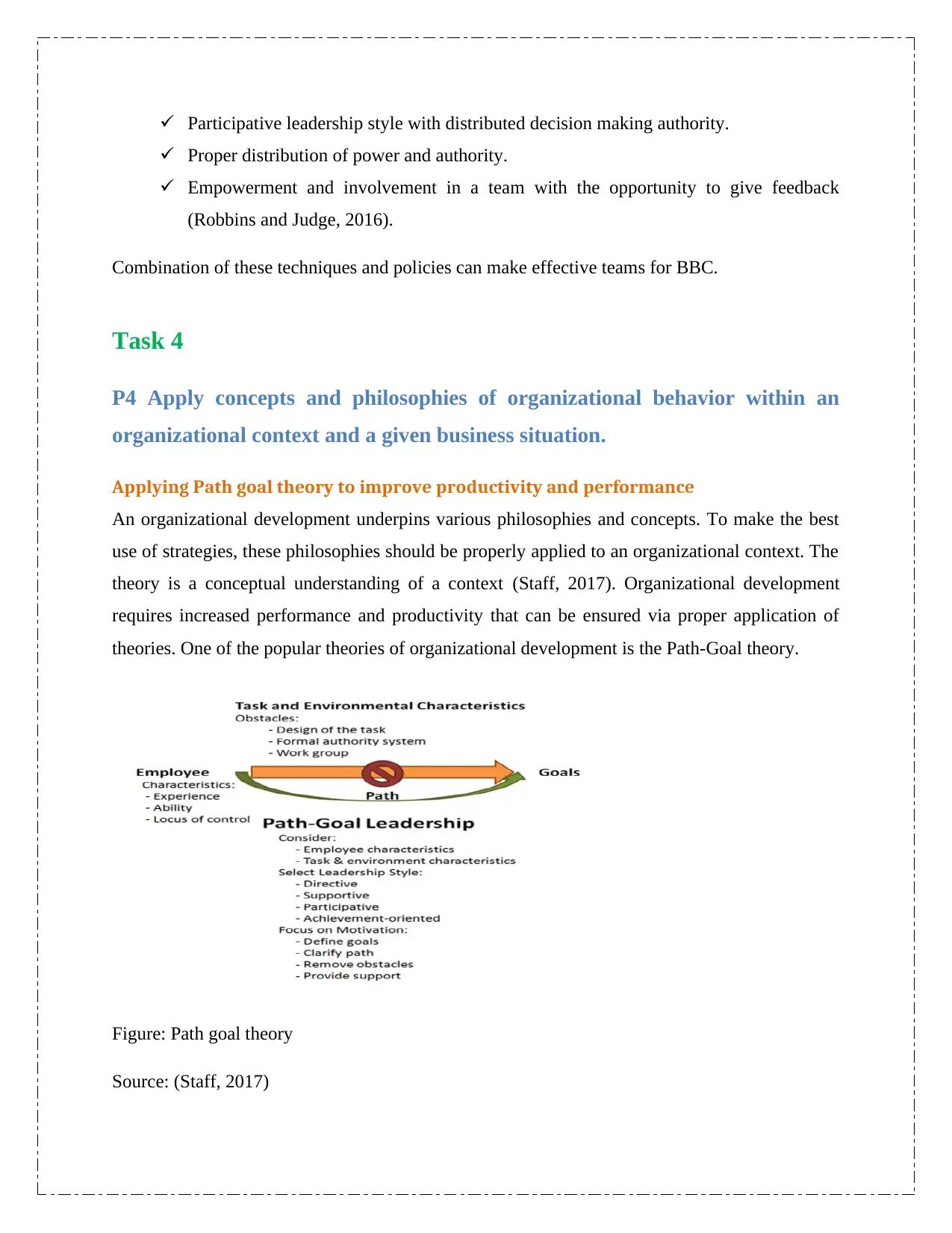
Participative leadership style with distributed decision making authority.
Proper distribution of power and authority.
Empowerment and involvement in a team with the opportunity to give feedback
(Robbins and Judge, 2016).
Combination of these techniques and policies can make effective teams for BBC.
Task 4
P4 Apply concepts and philosophies of organizational behavior within an
organizational context and a given business situation.
Applying Path goal theory to improve productivity and performance
An organizational development underpins various philosophies and concepts. To make the best
use of strategies, these philosophies should be properly applied to an organizational context. The
theory is a conceptual understanding of a context (Staff, 2017). Organizational development
requires increased performance and productivity that can be ensured via proper application of
theories. One of the popular theories of organizational development is the Path-Goal theory.
Figure: Path goal theory
Source: (Staff, 2017)
Proper distribution of power and authority.
Empowerment and involvement in a team with the opportunity to give feedback
(Robbins and Judge, 2016).
Combination of these techniques and policies can make effective teams for BBC.
Task 4
P4 Apply concepts and philosophies of organizational behavior within an
organizational context and a given business situation.
Applying Path goal theory to improve productivity and performance
An organizational development underpins various philosophies and concepts. To make the best
use of strategies, these philosophies should be properly applied to an organizational context. The
theory is a conceptual understanding of a context (Staff, 2017). Organizational development
requires increased performance and productivity that can be ensured via proper application of
theories. One of the popular theories of organizational development is the Path-Goal theory.
Figure: Path goal theory
Source: (Staff, 2017)
Paraphrase This Document
Need a fresh take? Get an instant paraphrase of this document with our AI Paraphraser
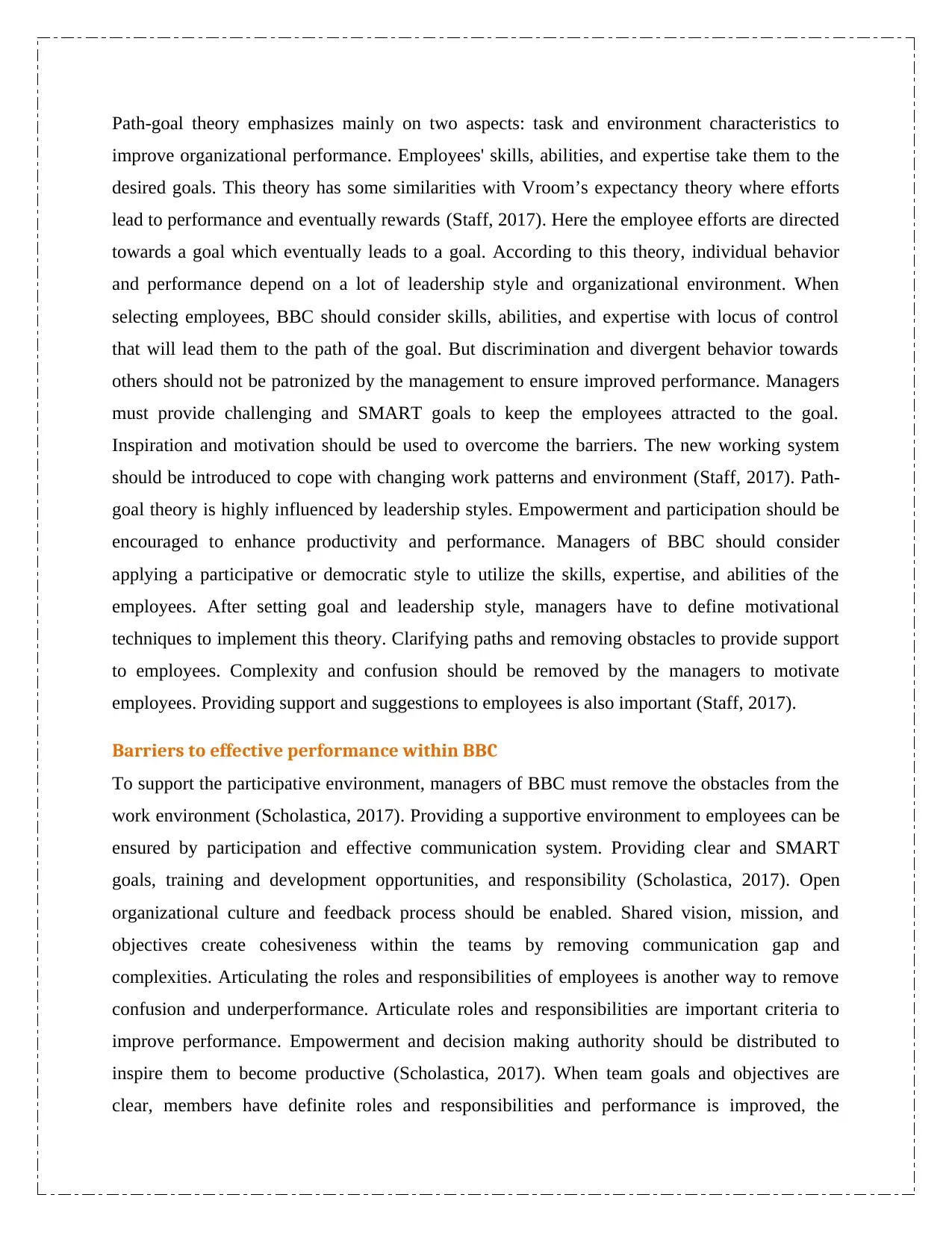
Path-goal theory emphasizes mainly on two aspects: task and environment characteristics to
improve organizational performance. Employees' skills, abilities, and expertise take them to the
desired goals. This theory has some similarities with Vroom’s expectancy theory where efforts
lead to performance and eventually rewards (Staff, 2017). Here the employee efforts are directed
towards a goal which eventually leads to a goal. According to this theory, individual behavior
and performance depend on a lot of leadership style and organizational environment. When
selecting employees, BBC should consider skills, abilities, and expertise with locus of control
that will lead them to the path of the goal. But discrimination and divergent behavior towards
others should not be patronized by the management to ensure improved performance. Managers
must provide challenging and SMART goals to keep the employees attracted to the goal.
Inspiration and motivation should be used to overcome the barriers. The new working system
should be introduced to cope with changing work patterns and environment (Staff, 2017). Path-
goal theory is highly influenced by leadership styles. Empowerment and participation should be
encouraged to enhance productivity and performance. Managers of BBC should consider
applying a participative or democratic style to utilize the skills, expertise, and abilities of the
employees. After setting goal and leadership style, managers have to define motivational
techniques to implement this theory. Clarifying paths and removing obstacles to provide support
to employees. Complexity and confusion should be removed by the managers to motivate
employees. Providing support and suggestions to employees is also important (Staff, 2017).
Barriers to effective performance within BBC
To support the participative environment, managers of BBC must remove the obstacles from the
work environment (Scholastica, 2017). Providing a supportive environment to employees can be
ensured by participation and effective communication system. Providing clear and SMART
goals, training and development opportunities, and responsibility (Scholastica, 2017). Open
organizational culture and feedback process should be enabled. Shared vision, mission, and
objectives create cohesiveness within the teams by removing communication gap and
complexities. Articulating the roles and responsibilities of employees is another way to remove
confusion and underperformance. Articulate roles and responsibilities are important criteria to
improve performance. Empowerment and decision making authority should be distributed to
inspire them to become productive (Scholastica, 2017). When team goals and objectives are
clear, members have definite roles and responsibilities and performance is improved, the
improve organizational performance. Employees' skills, abilities, and expertise take them to the
desired goals. This theory has some similarities with Vroom’s expectancy theory where efforts
lead to performance and eventually rewards (Staff, 2017). Here the employee efforts are directed
towards a goal which eventually leads to a goal. According to this theory, individual behavior
and performance depend on a lot of leadership style and organizational environment. When
selecting employees, BBC should consider skills, abilities, and expertise with locus of control
that will lead them to the path of the goal. But discrimination and divergent behavior towards
others should not be patronized by the management to ensure improved performance. Managers
must provide challenging and SMART goals to keep the employees attracted to the goal.
Inspiration and motivation should be used to overcome the barriers. The new working system
should be introduced to cope with changing work patterns and environment (Staff, 2017). Path-
goal theory is highly influenced by leadership styles. Empowerment and participation should be
encouraged to enhance productivity and performance. Managers of BBC should consider
applying a participative or democratic style to utilize the skills, expertise, and abilities of the
employees. After setting goal and leadership style, managers have to define motivational
techniques to implement this theory. Clarifying paths and removing obstacles to provide support
to employees. Complexity and confusion should be removed by the managers to motivate
employees. Providing support and suggestions to employees is also important (Staff, 2017).
Barriers to effective performance within BBC
To support the participative environment, managers of BBC must remove the obstacles from the
work environment (Scholastica, 2017). Providing a supportive environment to employees can be
ensured by participation and effective communication system. Providing clear and SMART
goals, training and development opportunities, and responsibility (Scholastica, 2017). Open
organizational culture and feedback process should be enabled. Shared vision, mission, and
objectives create cohesiveness within the teams by removing communication gap and
complexities. Articulating the roles and responsibilities of employees is another way to remove
confusion and underperformance. Articulate roles and responsibilities are important criteria to
improve performance. Empowerment and decision making authority should be distributed to
inspire them to become productive (Scholastica, 2017). When team goals and objectives are
clear, members have definite roles and responsibilities and performance is improved, the
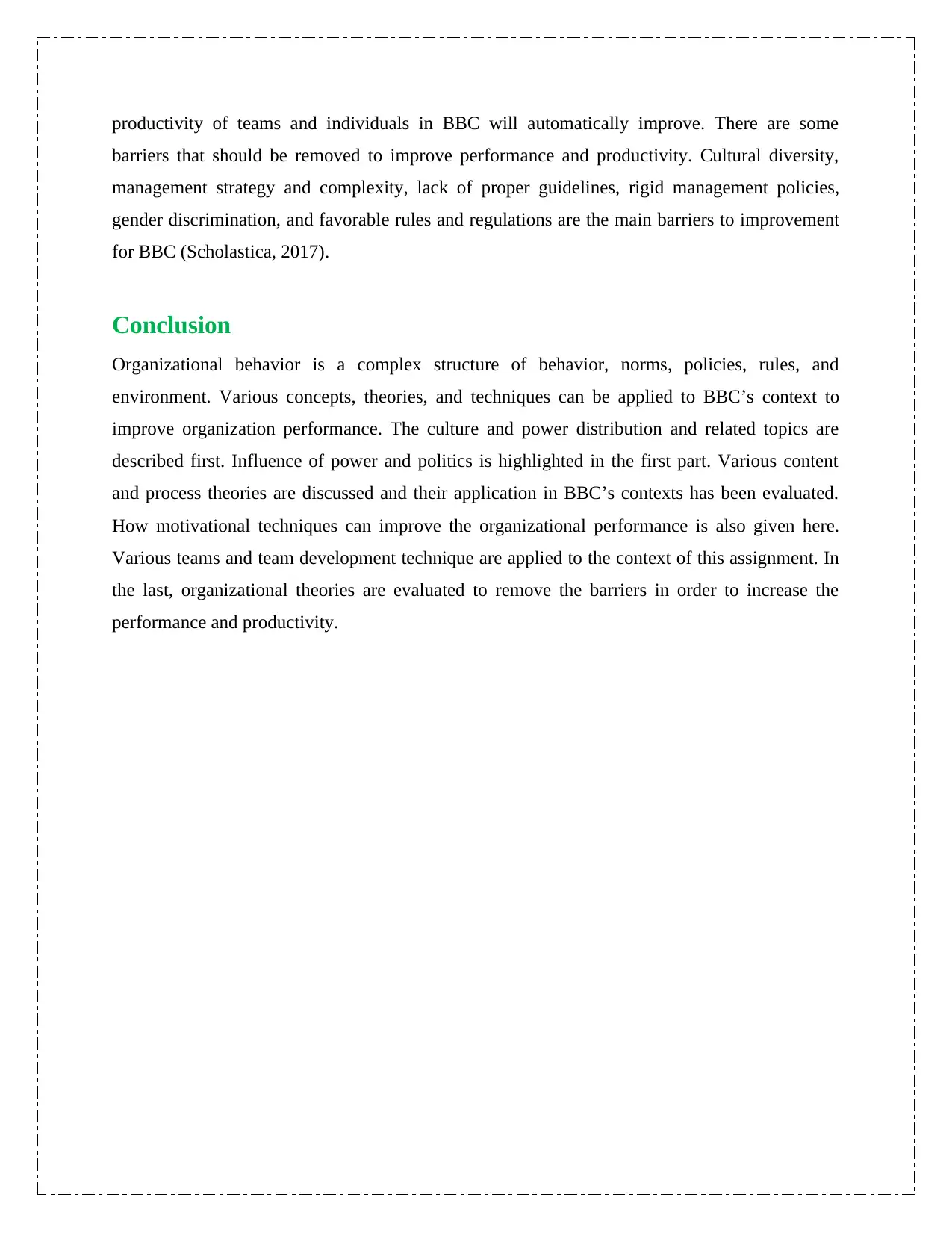
productivity of teams and individuals in BBC will automatically improve. There are some
barriers that should be removed to improve performance and productivity. Cultural diversity,
management strategy and complexity, lack of proper guidelines, rigid management policies,
gender discrimination, and favorable rules and regulations are the main barriers to improvement
for BBC (Scholastica, 2017).
Conclusion
Organizational behavior is a complex structure of behavior, norms, policies, rules, and
environment. Various concepts, theories, and techniques can be applied to BBC’s context to
improve organization performance. The culture and power distribution and related topics are
described first. Influence of power and politics is highlighted in the first part. Various content
and process theories are discussed and their application in BBC’s contexts has been evaluated.
How motivational techniques can improve the organizational performance is also given here.
Various teams and team development technique are applied to the context of this assignment. In
the last, organizational theories are evaluated to remove the barriers in order to increase the
performance and productivity.
barriers that should be removed to improve performance and productivity. Cultural diversity,
management strategy and complexity, lack of proper guidelines, rigid management policies,
gender discrimination, and favorable rules and regulations are the main barriers to improvement
for BBC (Scholastica, 2017).
Conclusion
Organizational behavior is a complex structure of behavior, norms, policies, rules, and
environment. Various concepts, theories, and techniques can be applied to BBC’s context to
improve organization performance. The culture and power distribution and related topics are
described first. Influence of power and politics is highlighted in the first part. Various content
and process theories are discussed and their application in BBC’s contexts has been evaluated.
How motivational techniques can improve the organizational performance is also given here.
Various teams and team development technique are applied to the context of this assignment. In
the last, organizational theories are evaluated to remove the barriers in order to increase the
performance and productivity.
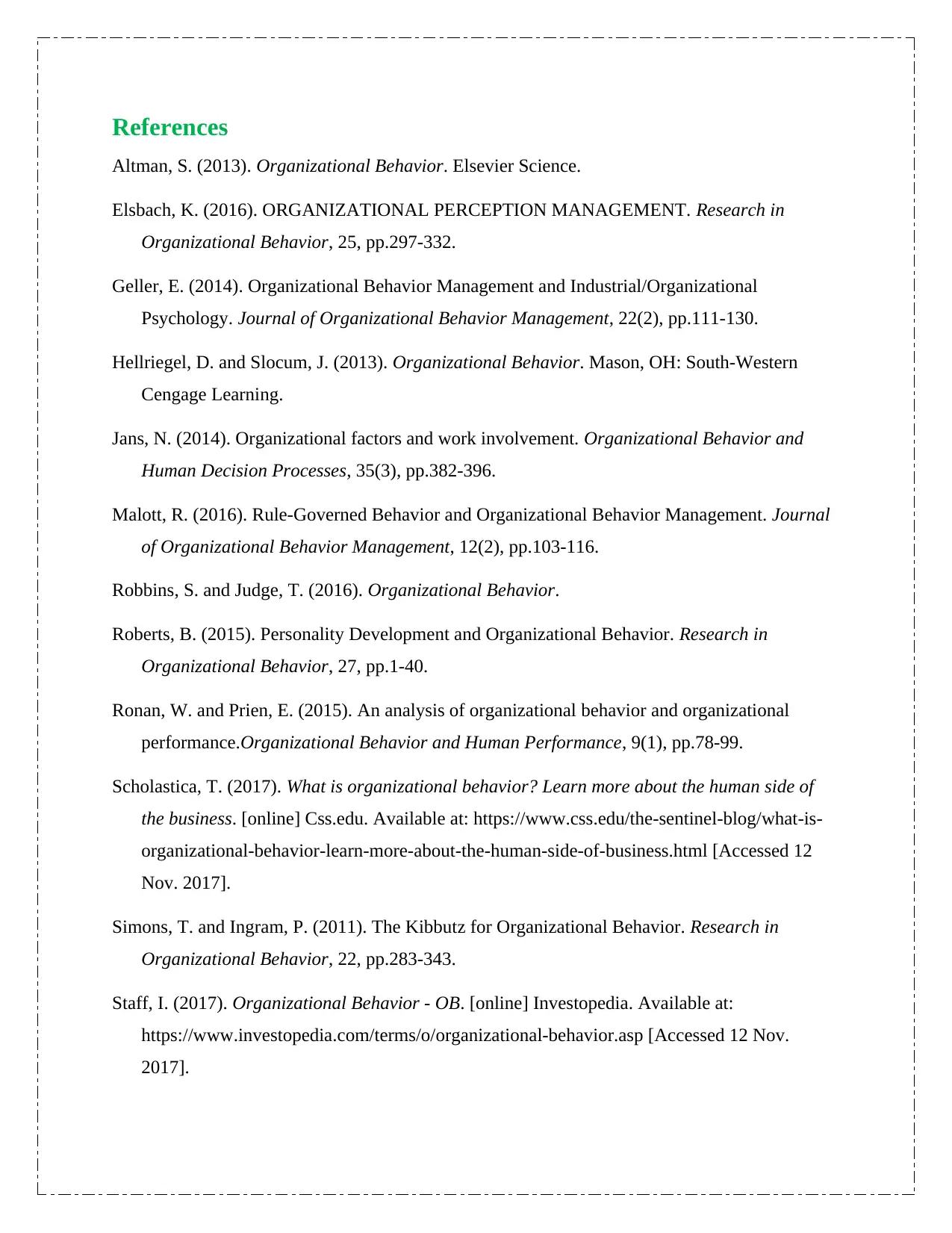
References
Altman, S. (2013). Organizational Behavior. Elsevier Science.
Elsbach, K. (2016). ORGANIZATIONAL PERCEPTION MANAGEMENT. Research in
Organizational Behavior, 25, pp.297-332.
Geller, E. (2014). Organizational Behavior Management and Industrial/Organizational
Psychology. Journal of Organizational Behavior Management, 22(2), pp.111-130.
Hellriegel, D. and Slocum, J. (2013). Organizational Behavior. Mason, OH: South-Western
Cengage Learning.
Jans, N. (2014). Organizational factors and work involvement. Organizational Behavior and
Human Decision Processes, 35(3), pp.382-396.
Malott, R. (2016). Rule-Governed Behavior and Organizational Behavior Management. Journal
of Organizational Behavior Management, 12(2), pp.103-116.
Robbins, S. and Judge, T. (2016). Organizational Behavior.
Roberts, B. (2015). Personality Development and Organizational Behavior. Research in
Organizational Behavior, 27, pp.1-40.
Ronan, W. and Prien, E. (2015). An analysis of organizational behavior and organizational
performance.Organizational Behavior and Human Performance, 9(1), pp.78-99.
Scholastica, T. (2017). What is organizational behavior? Learn more about the human side of
the business. [online] Css.edu. Available at: https://www.css.edu/the-sentinel-blog/what-is-
organizational-behavior-learn-more-about-the-human-side-of-business.html [Accessed 12
Nov. 2017].
Simons, T. and Ingram, P. (2011). The Kibbutz for Organizational Behavior. Research in
Organizational Behavior, 22, pp.283-343.
Staff, I. (2017). Organizational Behavior - OB. [online] Investopedia. Available at:
https://www.investopedia.com/terms/o/organizational-behavior.asp [Accessed 12 Nov.
2017].
Altman, S. (2013). Organizational Behavior. Elsevier Science.
Elsbach, K. (2016). ORGANIZATIONAL PERCEPTION MANAGEMENT. Research in
Organizational Behavior, 25, pp.297-332.
Geller, E. (2014). Organizational Behavior Management and Industrial/Organizational
Psychology. Journal of Organizational Behavior Management, 22(2), pp.111-130.
Hellriegel, D. and Slocum, J. (2013). Organizational Behavior. Mason, OH: South-Western
Cengage Learning.
Jans, N. (2014). Organizational factors and work involvement. Organizational Behavior and
Human Decision Processes, 35(3), pp.382-396.
Malott, R. (2016). Rule-Governed Behavior and Organizational Behavior Management. Journal
of Organizational Behavior Management, 12(2), pp.103-116.
Robbins, S. and Judge, T. (2016). Organizational Behavior.
Roberts, B. (2015). Personality Development and Organizational Behavior. Research in
Organizational Behavior, 27, pp.1-40.
Ronan, W. and Prien, E. (2015). An analysis of organizational behavior and organizational
performance.Organizational Behavior and Human Performance, 9(1), pp.78-99.
Scholastica, T. (2017). What is organizational behavior? Learn more about the human side of
the business. [online] Css.edu. Available at: https://www.css.edu/the-sentinel-blog/what-is-
organizational-behavior-learn-more-about-the-human-side-of-business.html [Accessed 12
Nov. 2017].
Simons, T. and Ingram, P. (2011). The Kibbutz for Organizational Behavior. Research in
Organizational Behavior, 22, pp.283-343.
Staff, I. (2017). Organizational Behavior - OB. [online] Investopedia. Available at:
https://www.investopedia.com/terms/o/organizational-behavior.asp [Accessed 12 Nov.
2017].
Secure Best Marks with AI Grader
Need help grading? Try our AI Grader for instant feedback on your assignments.
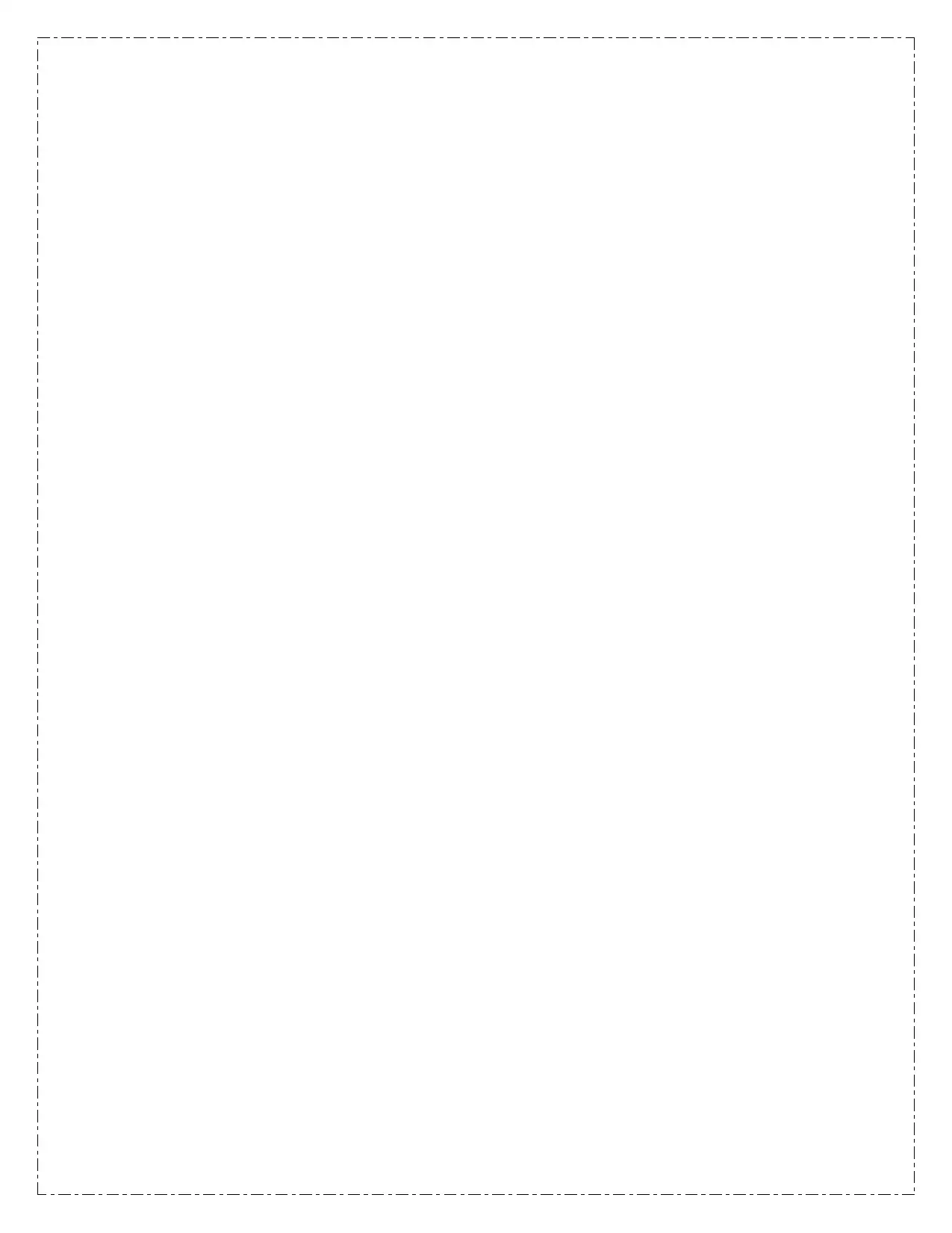
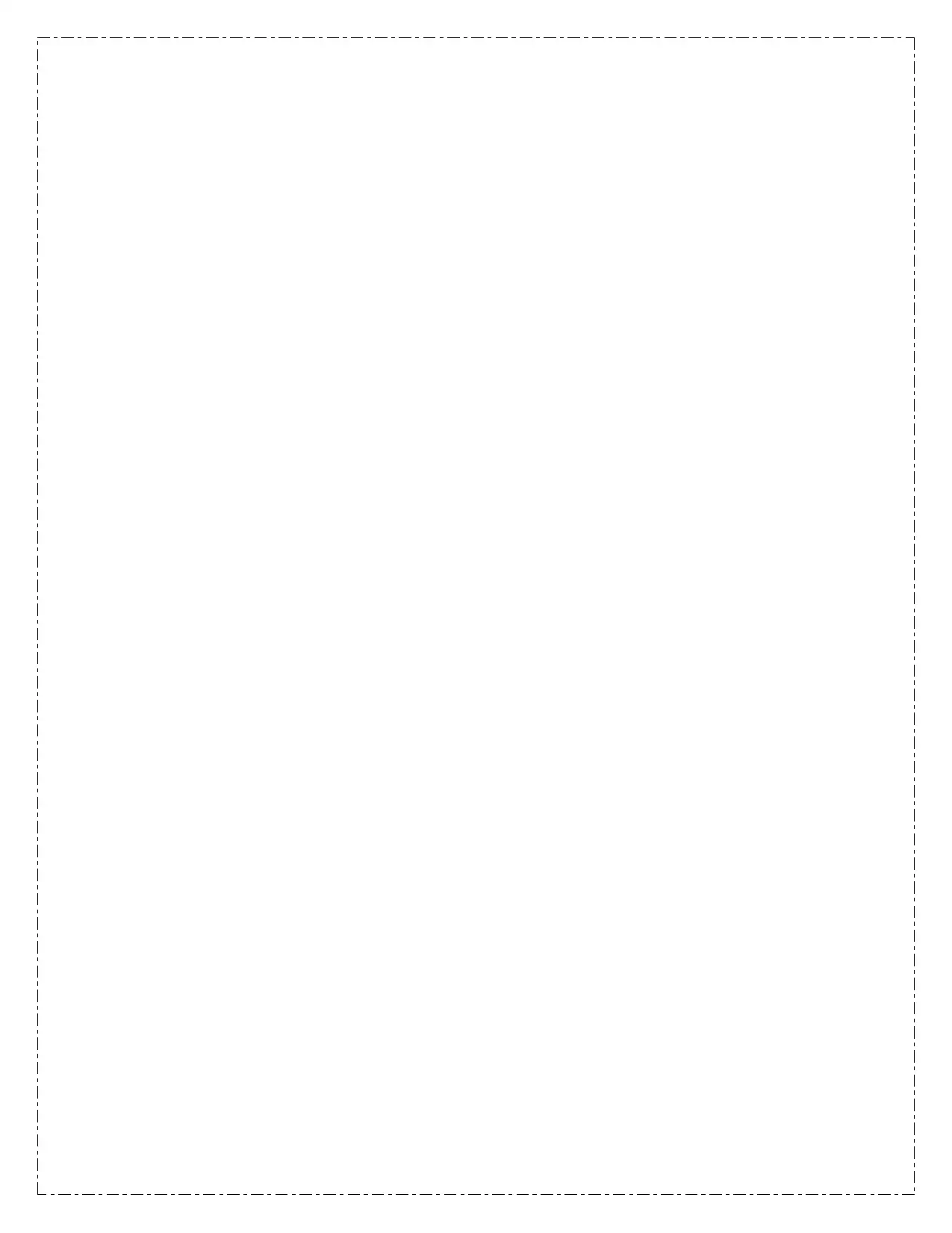
1 out of 18
Related Documents
Your All-in-One AI-Powered Toolkit for Academic Success.
+13062052269
info@desklib.com
Available 24*7 on WhatsApp / Email
![[object Object]](/_next/static/media/star-bottom.7253800d.svg)
Unlock your academic potential
© 2024 | Zucol Services PVT LTD | All rights reserved.





